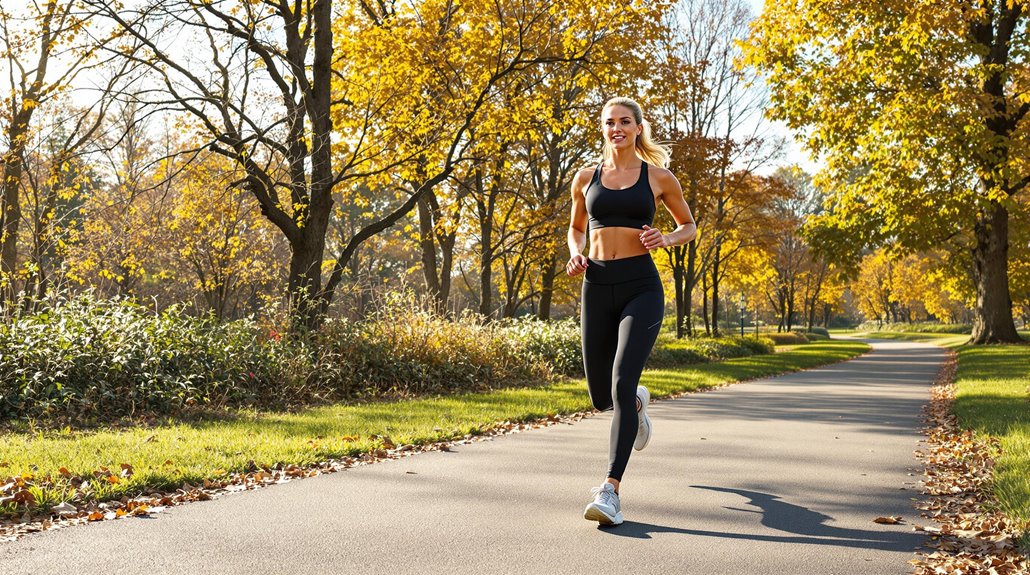Walking workouts provide an effective foundation for fitness with proper technique being essential. Start by maintaining good posture, keeping shoulders aligned with spine and abs engaged. Focus on heel-to-toe foot strikes while swinging arms naturally at 90-degree angles. Progress your routine through interval training, terrain variation, and gradual distance increases. Incorporate safety measures like wearing reflective clothing and staying aware of surroundings. For maximum benefits, aim for at least 20 minutes of walking five days per week. Master these fundamentals to reveal the full potential of this powerful exercise method.
Key Takeaways
- Master proper form with aligned posture, 90-degree arm swing, and heel-to-toe foot strikes to maximize walking benefits.
- To increase caloric burn, incorporate interval training by alternating between high-intensity bursts and recovery periods.
- Vary terrain with hills, stairs, and different surfaces to engage more muscle groups and enhance workout intensity.
- Establish consistency with three weekly sessions, including warm-up and cool-down routines, for sustainable fitness progression.
- Set SMART walking goals while gradually increasing distance by adding one block daily for measurable improvement.
Master Your Walking Form
Almost every aspect of walking form contributes to the effectiveness and safety of your workout. Proper posture serves as the foundation, beginning with a tall stance that aligns your shoulders, head, and neck with your spine. Keep your abs engaged and maintain spinal alignment by stacking your shoulders over your hips and hips over your knees, creating a strong, supported position that maximizes your walking efficiency. Regular practice of proper posture helps reduce chronic pain in your neck, back, and hips. Research shows that clinical studies recommend walking for at least 20 minutes, five days per week for optimal health benefits.
Your arms play a vital role in maintaining rhythm and balance. Bend your elbows at 90 degrees and keep them close to your body, allowing for natural arm swings that originate from your shoulders rather than your elbows. Maintain relaxed hands, as if holding something delicate, and avoid raising your arms above your sternum or swinging them across your body.
The mechanics of your foot strike greatly impact your walking effectiveness. Begin each step with a heel strike, then roll forward through the entire foot, pushing off with your toes. Focus on taking shorter, more deliberate steps rather than overstriding, which can stress your joints and disrupt your balance. To increase speed, opt for small, quick steps instead of lengthening your stride.
Perfect your technique by maintaining awareness of your surroundings while focusing your gaze 10-20 feet ahead. Warm up with a 5-minute walk before increasing your pace, and conclude your workout with a gradual slowdown and thorough stretching.
Once you’ve mastered the proper form, consider incorporating props like weighted vests or walking poles for added intensity.
Boost Your Walking Impact
Once you’ve mastered proper walking form, elevating the impact of your walks becomes the next logical focus. Transform your walking routine from essential exercise into a dynamic fitness experience by incorporating variety and strategic intensity adjustments. Using proper form, swing your arms naturally while walking to maximize upper-body engagement. Interval training is robust, alternating between high-intensity bursts and active recovery periods to maximize caloric burn and cardiovascular benefits. Regular walking sessions help reduce cancer risks, according to findings from the National Cancer Institute.
Experiment with diverse terrains and environments to challenge your body in new ways. Hills, nature trails, and stairs naturally intensify your workout, while beaches and varied surfaces engage different muscle groups. Integrate bodyweight exercises strategically using available infrastructure like benches or playground equipment to create a thorough full-body workout.
| Strategy | Method | Benefit |
|---|---|---|
| Interval Training | 2 min fast, 1 min recovery | Increased calorie burn |
| Terrain Variation | Hills and stairs | Enhanced leg strength |
| Midpoint Exercises | Bench dips, step-ups | Full-body engagement |
| Progressive Loading | Add 1 block daily | Sustainable improvement |
Gradually extend your walking distance by adding just one block each day to maintain momentum and guarantee lasting results. Implement a structured approach to progression while staying mindful of proper hydration and body response. Utilize technology selectively for accountability, but don’t hesitate to disconnect occasionally for mindful walking sessions. Create multiple routes to prevent monotony and maintain engagement, guaranteeing each walk offers a fresh perspective and challenge. This strategic approach transforms simple walks into powerful workouts that deliver thorough health benefits while keeping you motivated and engaged.
Walking Power Tools
The right equipment can dramatically enhance your walking workouts, transforming them into powerful full-body exercises. Modern fitness technology offers various tools designed to maximize the effectiveness of your walking routine while providing comfort, tracking capabilities, and resistance options for a more challenging workout.
High-performance treadmills with advanced digital features allow you to maintain your walking practice regardless of weather conditions. These machines offer versatile programming options, including incline variations and speed controls, enabling you to customize your workout intensity. Interactive trainer-led sessions provide expert guidance and motivation during your treadmill walks. Titan exercise equipment delivers free shipping on all carry workout gear for home gyms.
For those with space constraints, compact and space-saving treadmill designs provide an excellent solution for home fitness.
- Weighted Vests: Integrate resistance into your walking routine while maintaining proper form and engaging core muscles.
- Kettlebells: Incorporate carry exercises during walks to enhance grip strength and upper-body engagement.
- Digital Tracking Devices: Monitor progress, pace, and heart rate to optimize workout effectiveness.
- Ergonomic Walking Equipment: Utilize proper footwear and support gear to maintain comfort during extended sessions.
To maximize results, combine walking with carrying exercises using portable equipment like kettlebells or weighted vests. This combination targets multiple muscle groups while improving cardiovascular fitness and core strength.
The versatility of these tools allows you to progress at your own pace and gradually increase intensity as your fitness level improves. Incorporating these power tools into your walking routine allows you to create a more extensive workout that supports both strength development and cardiovascular health.
Smart Walking Progression
Progressive walking development requires a structured approach that builds from foundational stability to advanced mobility. The journey begins with mastering static standing balance before shifting to dynamic movement. By utilizing support surfaces and parallel benches, individuals can develop confidence in taking independent steps while maintaining proper form and balance.
Essential techniques include the sit-to-stand exercise, which establishes a solid base for balance, and cruising between parallel surfaces to practice weight shifting. The strategic use of wedges can facilitate forward weight transfer, while gradually increasing distances between support surfaces promotes natural progression. Incorporating motivating objects creates purposeful movement and maintains engagement throughout the process. Small benches positioned in front of support surfaces provide secure practice opportunities.
Setting smart walking goals transforms intention into action. Specific, measurable objectives provide clear direction, while attainable goals prevent discouragement. Progress tracking through journals or calendars maintains motivation and accountability. Time-bound plans create structure and help establish consistent walking routines. Individuals develop sustainable habits that support long-term mobility and independence by aligning walking goals with personal interests.
Through this systematic progression, walkers build strength, confidence, and endurance while minimizing the risk of setbacks. This foundation supports continued advancement toward more challenging walking objectives.
Walk Safe and Strong
Safety consciousness forms the cornerstone of an effective walking routine. As you embrace walking as a path to wellness, implementing proper safety measures guarantees you can focus on your fitness goals without compromise. Mastering defensive walking techniques and maintaining heightened awareness will create a protective foundation for your walking practice. Dress appropriately in layers for temperature changes to ensure comfort throughout your walk. Carrying a personal alarm device can provide added security during your walks.
Your visibility and predictability are vital in walking safety. Wear bright, reflective clothing that allows drivers and others to spot you quickly, especially during dawn, dusk, or nighttime walks. Move purposefully and follow established traffic rules while maintaining awareness of your surroundings. Stay alert to potential hazards, from uneven sidewalks to approaching vehicles, and always trust your instincts about your environment.
- Before each walk, inform a trusted person about your route and expected return time.
- Position yourself facing traffic when no sidewalk is available, maintaining maximum distance from vehicles.
- Utilize crosswalks and intersections, making deliberate eye contact with drivers to confirm your presence.
- Carry identification, emergency contact information, and a personal safety device like a whistle.
Empowerment comes through preparation and awareness. Keep electronic devices tucked away to maintain full sensory awareness of your environment. Choose well-lit routes with steady foot traffic when possible, and consider joining walking groups for added security.
Frequently Asked Questions
How Long Should I Wait After Eating Before Starting a Walking Workout?
For ideal health benefits, you should start walking immediately after eating.
Research shows that blood sugar levels peak 30-60 minutes after a meal, making immediate walking most effective for glucose management.
Even short 2-10 minute walks can meaningfully impact blood sugar levels and aid digestion.
If immediate walking isn’t possible, aim to start within 30 minutes of finishing your meal for maximum metabolic benefits.
Can I Achieve Weight Loss Goals Through Walking Alone?
While walking is a powerful tool for health and fitness, achieving weight loss goals through walking alone is challenging.
Research shows that combining walking with a calorie-restricted diet delivers the most effective results.
To maximize weight loss potential, incorporate varied intensities like power walking, uphill routes, or weighted vests, and aim for at least 30 minutes daily.
Should I Walk Differently on Different Surfaces Like Sand or Trails?
Adapting your walking technique to different surfaces is essential for safety and effectiveness.
On the sand, take shorter steps with a pronounced heel-to-toe motion for stability.
Maintaining quick, compact steps for trails while staying alert to terrain changes.
Keep your core engaged across all surfaces, and adjust your posture with your shoulders back and your eyes forward.
Consider using walking poles for additional stability on challenging terrain.
Is Walking Barefoot on Grass Beneficial for Fitness and Health?
Walking barefoot on grass offers numerous health benefits that can enhance your physical and mental well-being.
This natural practice, known as “earthing” or “grounding,” helps reduce inflammation, improve heart health, and strengthen foot muscles.
It also boosts mental wellness by releasing endorphins and reducing stress.
However, start gradually and choose clean, safe surfaces to prevent injury while embracing this liberating form of movement and connection with nature.
How Do Weather Conditions Affect Optimal Walking Speed and Duration?
Weather conditions greatly influence ideal walking speed and duration.
During rain, people naturally walk faster and choose shorter routes, completing walks in nearly half the time compared to sunny conditions.
Cold temperatures below ten °C and heat above 30°C prompt increased walking speeds, with sub-zero temperatures yielding the highest average speed of 0.677 m/s.
Snow and ice decrease speed by 0.102 m/s, while surface conditions affect stride patterns and stability.
Conclusion
Walking workouts offer an accessible, sustainable approach to improving overall fitness and maintaining an active lifestyle. Proper form, strategic intensity progression, and appropriate gear selection maximize health benefits while minimizing injury risk. With safety protocols and consistent practice, walking becomes a powerful tool for cardiovascular health, weight management, and mental well-being. This fundamental exercise remains one of the most effective methods for achieving long-term fitness goals.


